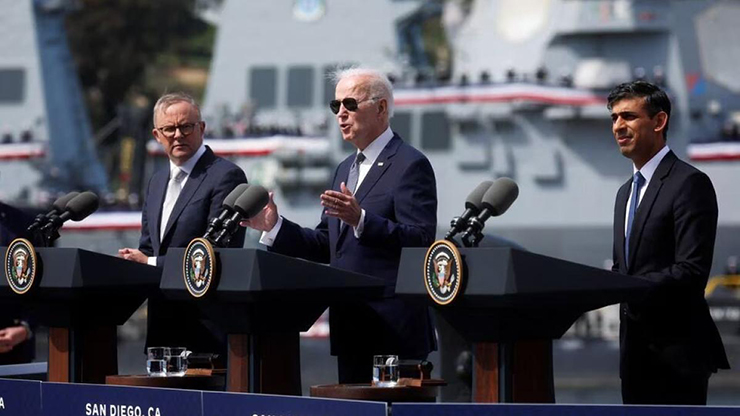
Washington: The US Navy is beginning to integrate its industrial base with those of Australia and the United Kingdom, despite Congress not yet passing several measures to enable the trilateral submarine-building arrangement AUKUS.
AUKUS will bring about the sale of American submarines to Australia and the development of a new AUKUS-class design, but US Navy Under Secretary Erik Raven recently told lawmakers the agreement goes beyond acquisition programs.
“It is about fundamentally changing and integrating three industrial bases in different parts of the world to produce maximum effect to serve our mutual national security efforts,” Raven said, noting such efforts are already underway.
Rear Admiral Scott Pappano, the program executive officer for strategic submarines, recently said at an additive manufacturing summit in Danville, Virginia, that the Columbia-class ballistic missile submarine program is tightly linked to its British counterpart, the Dreadnought program. Of particular importance is the bilateral collaboration in casting metal pieces for their common missile tubes.
Castings is among the weakest sectors in the US submarine-industrial base, and something the US Navy is actively trying to address by pouring money into vendors’ workforces and facilities, while also looking for new technologies — like additive manufacturing — to supplement traditional vendors’ output.
Pappano said his office, which also manages overall submarine-industrial base issues, has been looking at ways to use the UK castings sector and leverage the country’s castings suppliers.
Matt Sermon, the executive director at the strategic submarines office, said at the summit that Australian 3D-printing company AML3D would join a research and development effort at the Additive Manufacturing Centre of Excellence in Danville. The company’s machine uses a different printing technique than those already there, which could help the Navy advance its knowledge of the directed-energy deposition printing method and a nickel aluminium bronze alloy the service wants to use for printing submarine parts.
Sermon also noted a handful of Australian students had come through the Accelerated Training in Defence Manufacturing schoolhouse across the street from the centre of excellence. This partnership was meant to be a train-the-trainer arrangement, meaning students will return to Australia where they will establish an accelerated training centre to locally grow a submarine workforce in support of AUKUS.
US Navy Secretary Carlos Del Toro attended the summit and said these efforts are critical for the service, adding that AUKUS is “incredibly important to our national security interests five years from now, 10 years from now, 20 years from now.”
The secretary noted he’s “very comfortable” in the submarine-industrial base’s ramp-up ahead of a 40-year-long heavy workload, but said more must be done to bolster the workforce — something Australia and the UK can help with that.
“Being able to bring Australian skilled workers here to the United States to participate in US companies, and to also go back to Australia and participate in future Australian companies that are also helping to maintain, repair and build future SSN-AUKUS type ships — that’s a win-win situation for our allies and partners working together to make this happen,” he said.
During an October 25 hearing before the House Armed Services Committee’s sea power panel, Raven said the Naval Criminal Investigative Service is establishing a presence in Australia to manage security and counter intelligence issues surrounding the submarine-sharing arrangement.
And Rear Admiral Jon Rucker, the program executive officer for attack submarines, said an existing workforce cross-training program on the Columbia and Dreadnought classes would be expanded to attack subs as well. Under that program workers from the General Dynamics Electric Boat shipyard in Connecticut and BAE Systems’ Barrow yard in England exchange places to ensure they’re both performing welding, non-destructive testing and other activities to the same standards.















